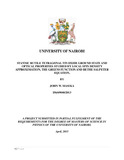| dc.description.abstract | Tin occurs in two main oxides; stannic oxide (SnO 2) and stannous oxide (SnO). The two
oxides depicts the dual valence of tin, with oxidation states of 2+ and 4+. Stannous oxide is less
well characterized than SnO2. Its electronic band gap is not accurately known but has been
estimated to be somewhere in the range of 2.5–3 eV. Thus stannous oxide exhibits a smaller band
gap than stannic oxide, which is largely quoted to be 3.6 eV. There are no single crystals
available that would facilitate more detailed studies of stannous oxide. As such not much has
been done about this oxide. Stannic oxide is the most abundant form of tin oxide [10] and it has
more technological significance in gas sensing applications, photo electronic applications and
oxidation catalysts. Furthermore besides its common rutile tetragonal structured SnO2 phase
there also exists a slightly more dense orthorhombic high pressure phase. Suito et al. showed that
in a pressure–temperature diagram the regions of tetragonal and orthorhombic phases can be
separated by a straight line of the equation p (kbar) = 140.0 + 0.022T (°C).
Owing to the vast applications of stannic Tin Oxide in the field of transparent conducting
metal oxides, this project seeks to establish the structural properties, electronic and optical
properties of stannic rutile tetragonal tin oxide using purely theoretical predictions. In this
project, the ground properties of SnO2 have been studied using Quantum-ESPRESSO code,
while the optical properties have been probed using yambo code. The ground state properties are
studying using the Local Spin Density Approximation (LSDA). The band gap of SnO2 is found
to be 3.6eV a value that agrees with the theoretical value. The Greens Function and the
dynamically screened interaction (GW) and the Bethe Salpeter Equation (BSE) have been used
to study the absorption energy and the electron energy loss spectra. By the BSE, the value of the
band gap is found to be 3.5eV which is close to the available experimental values showing a
variance of -2.78% from the experimental value. The absorption spectra obtained from the BSE
calculations show that the maximum light absorbed by SnO2 is in the UV wavelength near 10nm
which posses that SnO2 is a good absorber of UV of the electromagnetic spectrum. The
following SnO2 parameters were used in this work: a=b= 4.1485A° and c=2.6620A°[1,3,6] .
This was done by computational methods on SnO2 under its normal manifestation. | en_US |

